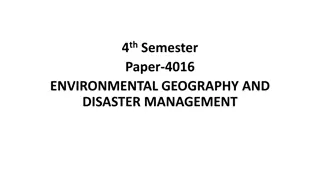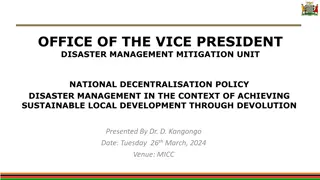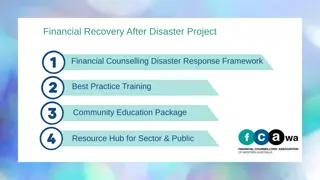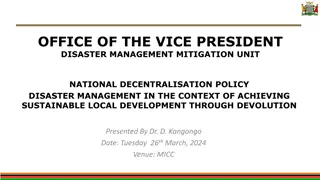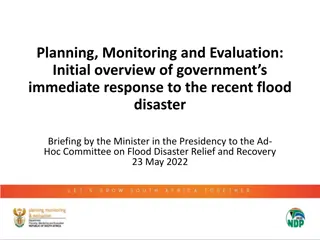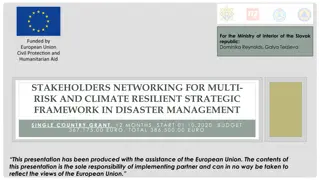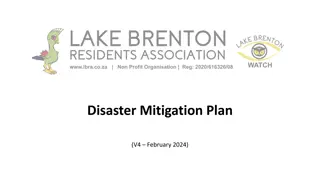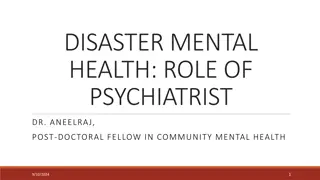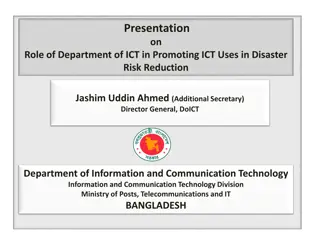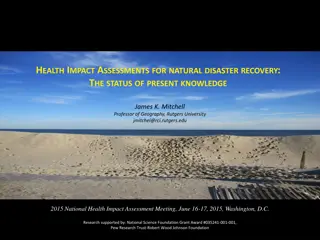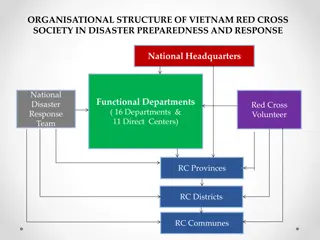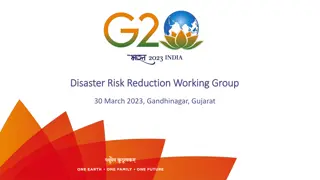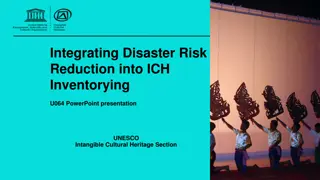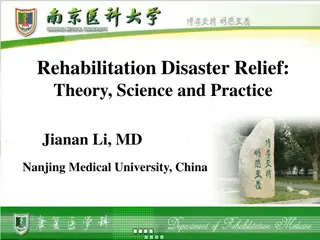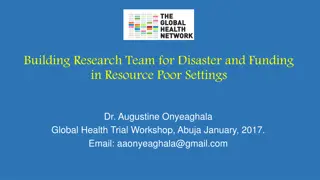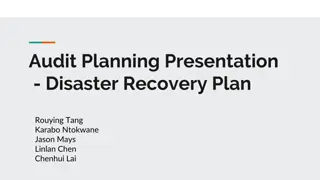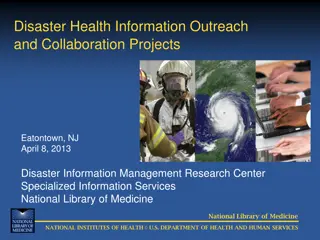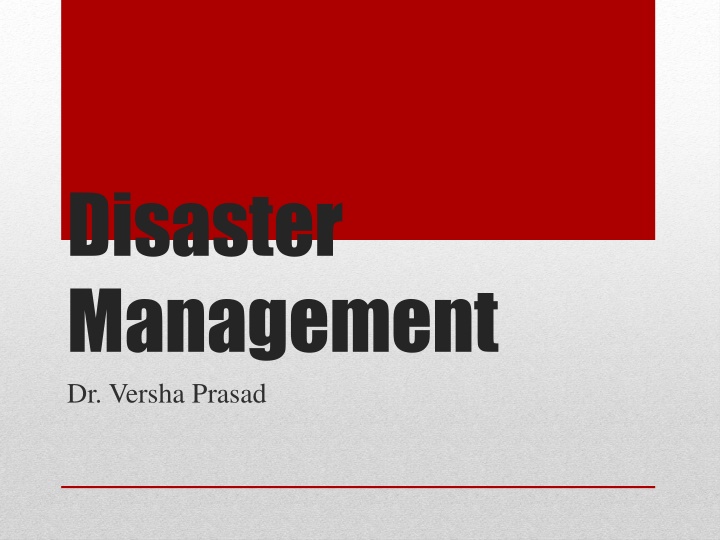
Disaster Management: Types, Steps, and Importance
Learn about disaster management, including types of disasters, major steps in managing a disaster, and the importance of mitigation, preparedness, response, and recovery. Understand the classifications of disasters and how they are managed to reduce impact and protect lives.
Download Presentation

Please find below an Image/Link to download the presentation.
The content on the website is provided AS IS for your information and personal use only. It may not be sold, licensed, or shared on other websites without obtaining consent from the author. If you encounter any issues during the download, it is possible that the publisher has removed the file from their server.
You are allowed to download the files provided on this website for personal or commercial use, subject to the condition that they are used lawfully. All files are the property of their respective owners.
The content on the website is provided AS IS for your information and personal use only. It may not be sold, licensed, or shared on other websites without obtaining consent from the author.
E N D
Presentation Transcript
Disaster Management Dr. Versha Prasad
Any Natural or human made calamities that causes severe damage to the livelihood is termed as a disaster. We cannot prevent the occurrence of a natural disaster but we cane reduce the after effects caused by the disaster by means of proper management. In simple words Disaster management is the way of dealing with human, material and economic impact of the said disaster. Disaster Management
In general, Disasters are of two types: 1. Natural Disaster Earthquake, Floods, Landslide, Volcano eruption, cyclone 2. Manmade Disaster Biological, Chemical and Nuclear disasters Disaster management is multilayered. It is used to address the people affected due to the above mentioned any of the calamity and helps them with good medical care food and housing. What is Disaster ?
Disasters are broadly classified into four types: 1. Pandemic emergencies we are well used for this word for the past two years. This type of disaster is the spread of contagious disease all over the country and it results in various health issues. It also results in death of many people. It indirectly affects the economy very badly. 2. Natural disasters This includes floods, earthquakes, Tsunami, hurricane etc Due to this type of disasters many peoples would lose their house, job and even family. It also results in death of many peoples. 3. Environmental Emergencies This type of disaster is due to Industrial accidents. It is mainly due to the use of hazardous materials. It pollutes the environment. 4. Complex emergencies This type of disaster occurs when the government collapses. It results in war. TYPES OF DISASTERS
There Are Four Major Steps In Managing A Disaster. It is also called as emergency management. 1. Mitigation This step involves reducing the impact of the disaster or eliminating it completely. It helps to reduce loss of property and lives. 2. Preparedness As the name suggests one must be prepared to face the consequence caused by the disaster. This also includes training and exercise. Hence this process needs more safety and security measures. 3. Response This describes the action taken in response to the results caused by the disaster therefore more resources are needed for this process. 4. Recovery This is the final step of disaster management. It denotes that all service are fully recovered and normal situation is attained Hence, we can say that the cycle involves action before during and after any disaster occurs. TYPES OF DISASTER MANAGEMENT
They are widely classified into eight categories: 1. Technological It involves scientific tools or technique to benefit disaster management. 2. Social It represents the society and its members. 3. Environmental all natural and built environment comes under this factor. 4. Legal It covers Law, rules and regulations for managing a disaster. 5. Economical They are of two types Long term economic planning measures and Financial factors. 6. Operational it is related to skills and operational competencies. 7. Institutional institution for managing a disaster is covered in this factor. 8. Political issues related to political parties are considered in this factor. FACTORS TO CONSIDER FOR DISASTER MANAGEMENT
The main purpose of disaster management is to understand the disaster and take necessary rescue operation. It is also used to provide relief measures such as arranging a rehabilitation program. Another main aim of disaster management is to control the death rate. It also aims at protecting the environment and minimizing the losses. PURPOSE OF DISASTER MANAGEMENT
There are various benefits in managing a disaster. By doing so huge loss can be prevented. In man made case even the disaster can be prevented. It is cost efficient because for recovery we use multiple components Hence, we can conclude that by proper planning and preparedness any disaster can be faced without huge losses. ADVANTAGES OF DISASTER MANAGEMENT
Risk & Hazard Assessment Planning Organization Resource Utilization Need for Specialists Training Principles of Disaster Management
Disaster risk will be a combination of the likelihood of the event and the vulnerability of a place to that event. The hazard assessment will aim to deliver accurate disaster information about individual locations. RISK AND HAZARD ASSESSMENT
Vulnerability to a particular hazard will include : Critical products, services, records and operations. Hazardous materials Potential effects of damage on stakeholders. financial costs. Resources personnel and time available to make preparations. Level of insurance cover. The combination of hazard and vulnerability assessments will result in formulating total risk assessment. Likely HAZARD ASSESSMENT
to have a clear and logical approach to dealing with disasters. to provide common reference for all departments and authorities with roles. to assist with information for sitting-up a multi- functional organizational structure. to form a basis for coordinated action. to provide clear allocation of responsibilities. to form a basis for reviewing and evaluating current and future disaster management requirements. to give a focus for disaster related training. Planning
the nature of National Disaster Management Authority (NDMA) Utilization of total governmental structures/ resources i.e. National, State & Local level. Co-ordination of non governmental resources Community involvement Clear lines of Authority and unity of command Special system requirements. Center/Control Center Direction & Coordinating Authority Communications Warning Systems Assessments Information Management Logistics Emergency Operation Survey & Emergency Organization :
Identification of resources Assessment of resources with relation to their capability & availability Allocation of appropriate tasks Level of skill in handling allotted tasks and experience Activation time for deployment/availability Co-ordination with line authorities of resource organizations Coalition of accurate information for effective deployment of resources. Resource Utilization :
Identification of Training needs. Scope of Training programs. Training policy. Implementation of training. Design of training should be compatible to support tasks required to be performed after a Disaster at three levels. Foundational Training Team Training Combined Organizational Training. Training Training : :


